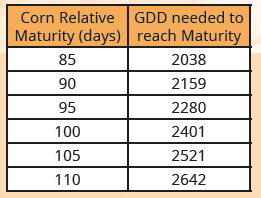Corn Test Weight: Lighter than Average?
2019 Growing Conditions & Corn Test Weight
Late planting and frost dates in the north likely had the greatest impact on corn test weights this year, but test weight is affected by a variety of factors.
 Margaret Smith, PhD
Margaret Smith, PhD
Forage Agronomist
Albert Lea Seed
REASON #1: Delayed Planting Dates
The 2019 crop year began with above-average early-season rainfall and delayed planting in many areas across the Upper Midwest (Table 1).
Planting was delayed most severely in Wisconsin, with only 58 percent of the corn crop planted by June 2, compared with the long-term average of 91 percent. Though many of these acres were designated as ‘Prevented Planting’, much corn eventually was planted, just later than average.
Table 1. Corn Acres Planted: 2019 Compared to 5-yr Avg for Minnesota, Iowa, and Wisconsin1
REASON #2: Growing Degree Days
Late planting for corn always reduces total Growing Degree Days (GDD) available for development before frost dates. Through July and August seemed cool, GDD accumulation from either May 1 or June 1 through our first frost dates (October 11-13) didn’t vary much from the long-term average (Table 2).
Table 2. 2019 GDD Accumulation from May 1 and June 1 Through October 11 at Four Locations.2
A warm September made up some of the earlier season lag in GDD accumulation. Later-season warm temperatures don’t completely make up the difference in corn development, though, as less sunlight is available in September to drive photosynthesis than earlier in the summer.
Most farmers who planted late replaced their full-season corn for shorter-maturity hybrids, but were those maturities ‘short’ enough? (Table 3) Though the severity of frost from October 11-13 varied across the Upper Midwest, some fields ended growth on those dates. These fields will have lighter test weights than those that matured before freezing.
Table 3. Corn relative maturities and estimated Growing Degree Days (GDD) need to mature the crop.
REASON #3: Corn Diseases
Despite excessive rain this year, corn had fairly low incidence of leaf diseases. We observed a fair amount of corn rust, but not enough likely to cause any economic yield loss. We also observed a number of Northern Corn Leaf Blight infections, but at low levels. In late September, anthracnose in some fields started to cause some top die-back. This was most prevalent on corn-on-corn acres.
This autumn’s late rain and cooler temperatures increase the potential for crown and stalk diseases to set in.
Some ear rots have taken hold late in the season. Further rain, high humidity and cool temperatures as corn stands in the field to dry will raise the risk of infection. Corn ear that have some insect feeding or other injury are likely the first to be affected, followed by those plants that are holding the ears more upright, with tighter husk covers, allowing moisture to sit in the ear longer. Fields affected by disease likely will produce light test weights.
REASON #4: Drying Corn
As corn dries, it shrinks and packs better into a given volume, so test weight increases. Drier corn is also ‘slicker’ which improves packing. When corn matures before freezing and dries naturally in the field, test weight increases about 0.5 lbs per bushel per point of moisture removed. Increase in test weight with high temperature, mechanical drying is only about 0.25 lbs/bushel per point of moisture removed.
This relationship is most pronounced with grain that reaches physiological maturity (compared to grain damaged by frost) and contains moistures from 30 percent down to about 16 percent (Table 4). The more damaged kernels in grain, the less gain in test weight with drying.
This relationship of increasing test weight with drying may vary with grain below 20 percent moisture. As corn dries nearer safe storage moistures, test weight may not change, or in some cases, may decrease slightly, because kernels can lose moisture without changing kernel shape.
Table 4. Increase in test weight for mature corn harvested between 30 and 16 percent kernel moisture and dried to 15.5 % moisture.3
What Causes Light Test Weight in Corn?
Genetic variability among hybrids can affect grain test weight, but other factors contribute more to variability from growing season to growing season. Other factors influencing test weight include:
1. Grain Moisture
One of the most important factors influencing test weight. Wetter kernels are more plump and don’t pack as well in a volume measure. The good news: corn test weight increases as grain dries.
2. Late Planting
Delays the grain fill period into fall’s cooler temperatures and less solar radiation available to support grain fill.
3. Stress During Grain Fill
Adverse environmental conditions can limit the photosynthetic capacity of plants. Stress factors include:
- Drought
- Excessive moisture, which limits oxygen available to roots
- Cool temperatures and limited heat unit accumulation or limited sunlight
- Late-season leaf diseases, especially gray leaf spot, anthracnose, & Northern corn leaf blight
4. Ear Rots
Infestation of fungal pathogens diplodia, gibberella, etc. will result in lighter weight, diseased, and broken kernels.
5. Early Freezing in Fall
When temperatures reach freezing before corn reaches physiological maturity (black layer), plant development stops and prevents the final stages of grain fill.
6. Kernel Physical Characteristics
Size and shape of corn kernels and slickness of the corn seed coat affect how well kernels pack into a volumetric measure.
References
1Table 1 adapted from USDA NASS Crop Progress Reports, Iowa, Minnesota, Wisconsin
2 Adapted from: https://mrcc.illinois.edu/U2U/gdd/
3 Adapted from Hall and Hill, 1974
Corn Grain Test Weight. R.L. (Bob) Nielsen), Purdue University.
www.agry.purdue.edu/ext/corn/news/timeless/TestWeight.html
Corn Test Weight Changes During Drying. Dale Hicks, 2004. Minnesota Crop News
Corn Yield Not Related to Test Weight. North Dakota State University www.ag.ndsu.edu/news/newsreleases/2012/aug-20-2012/grain-yield-not-related-to-test-weight/
Grain Test Weight Deception Carl Bern, Iowa State University. store.extension.iastate.edu/Product/13246
Test Weight Adjustment Based on Moisture Content and Mechanical Damage of Corn Kernels. Glenn Hall and Lowell Hill. 1974. Trans ASAE 17: 578-579.
Test Weight and Yield: A Connection? Emerson Nafziger, Univeristy of Illinois bulletin.ipm.illinois.edu/pastpest/articles/200323h.html
Understanding Corn Test Weight. Mike Rankin UW Extension Fond du Lac University of Wisconsin. fyi.extension.wisc.edu/grain/files/2009/12/CornTW09.pdf
Why Grain Test Weights Matter. Todd Whitney, University of Nebraska. cropwatch.unl.edu/2017/why-grain-test-weights-matter




